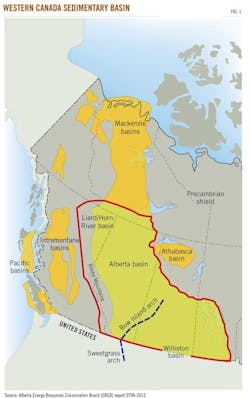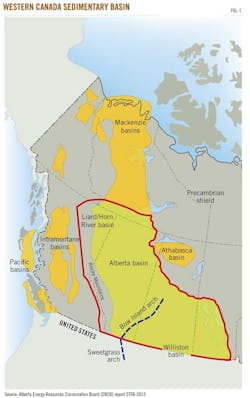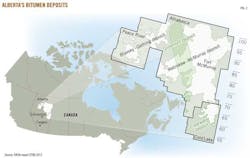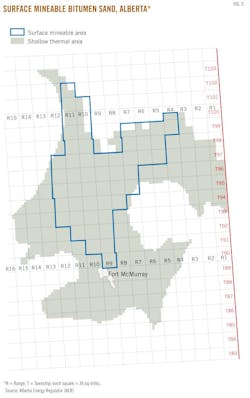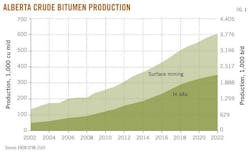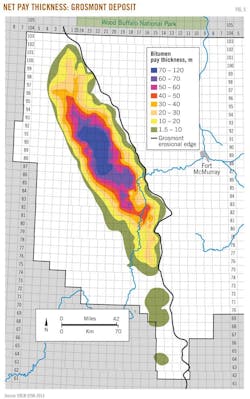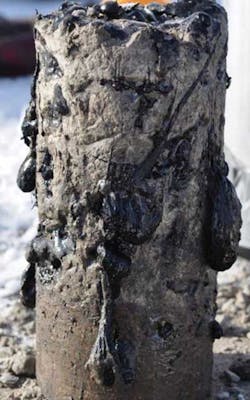Grosmont carbonate formation increases Alberta's bitumen reserves
Mike Priaro
Independent Consultant
Calgary
Improved recovery factors for Alberta's bitumen sands are elevating the province's reserves estimate to compete with some of the largest in the world. Results from commercial pilots in Alberta's Grosmont bitumen carbonates indicate additional very large new reserves in Alberta's bitumen carbonates.
The Western Canada Sedimentary basin (WCSB) extends from the Williston basin, which straddles the Canada-US border, north to the Mackenzie basins, west to the Rocky Mountains, and east to the edge of the Precambrian shield (Fig. 1).
Historical production
The WCSB is historically gas prone with large volumes of conventional gas that have supplied Eastern Canada and the US for more than 50 years. Recently, the Alberta Energy Resources Conservation Board (ERCB), now the Alberta Energy Regulator (AER), along with the Alberta Geological Survey (AGS) estimated 3,424 tcf of original-gas-in-place and 59 billion bbl of original-NGLs-in-place in only six of 15 Alberta tight shale and siltstone formations that are in early stages of development.1
Production of conventional oil (pipeline quality or lighter than ~20° API) started in the WCSB with discovery of oil at Turner Valley in the 1930s, expanded greatly with discovery of the Leduc reef trend by Imperial Oil in 1947, and peaked at 1.4 million b/d in 1973.
In Alberta, the first Europeans to enter the region more than 200 years ago noted bitumen seeps along the banks of the Athabasca River in the northern portion of the province. The local Aboriginal people had long been using bitumen to waterproof canoes. Bitumen is crude with a specific gravity greater than fresh water (less than 10° API) and is a thick, semisolid fluid at room temperature that does not flow at commercial rates under normal reservoir conditions.
Karl Clark, a scientist with the Alberta Research Council in the 1920s, pioneered experiments with a hot water flotation process. He mixed bitumen sand with hot water and aerated the resultant slurry, which would then separate into a floating froth of bitumen and a clean layer of sand that settled to the bottom of the tank. An industrial plant north of Fort McMurray used this hot water flotation process to produce bitumen for roofing and road surfacing at the time.
In 1936, Abasand Oils Ltd.'s plant west of Fort McMurray produced diesel oil from the bitumen sands until it burned down in the 1940s. In 1962, the government of Alberta announced a policy to provide for the orderly development of the bitumen sands and Suncor's Great Canadian Oil Sands project, the world's first large-scale bitumen sands project, came on stream in 1967.
Bitumen sands, production methods
Shallow, bitumen-saturated, unconsolidated sand or hard-rock carbonate reservoirs underlie 54,132 sq. miles of land in northern Alberta in the Alberta basin portion of the WCSB (Fig. 2).
Depending on depth, raw bitumen is produced either by surface strip-mining or by various in situ techniques using wells. Alberta contains 1,854 sq miles of surface mineable bitumen sands deposits (Fig. 3).
Bitumen sands reservoirs are generally thick and high quality and lie less than 250 ft deep allowing bitumen to be extracted economically by strip mining with recovery factors often exceeding 90%. In this method, overburden is stripped, bitumen sands are mined by excavation, and raw bitumen is separated from mined material with the hot water process. In the surrounding shallow thermal area there is risk of high-pressure steam and heated bitumen breakthrough to surface (Fig. 3).
The raw bitumen is then either diluted with condensate to allow pipeline transportation as diluted bitumen (dilbit; ~20° API). Raw bitumen can also be upgraded to synthetic crude oil (SCO or syncrude) at ~30° API and higher, which can then either be pipelined or refined. Upgrading entails decoking and processing raw bitumen to produce an SCO that is more valuable and desirable as refinery feedstock.
The eight surface strip-mining projects currently operating and under development are CNRL Horizon, Suncor Fort Hills, Imperial/ExxonMobil Kearl, Shell Muskeg River, Shell Jackpine, Suncor, Syncrude, and Total Joslyn North. The just-commissioned Kearl project and the in-development Fort Hills project are the first surface strip mines without upgraders. Kearl is also the first to use a solvent process to separate bitumen from sand.
Bitumen is recovered at greater depths with enhanced in situ thermal recovery techniques such as cyclic steam stimulation (CSS) or steam-assisted gravity drainage (SAGD).
In CSS, the first in situ enhanced recovery method developed, high-pressure steam is injected into a well for months and then produced back from the same well for several more months. The cycle is then repeated.
In SAGD, pairs of parallel horizontal wells, one about 15 or 20 ft above the other, are drilled from a pad. High-pressure steam is continuously injected into the upper well to heat the reservoir and reduce the viscosity of the bitumen, allowing it continuously to drain into the lower horizontal wellbore for production. SAGD is currently the technique of choice for most in situ projects under development.
The Alberta Energy Resources Conservation Board forecast bitumen production doubling to 3.8 million b/d from 2012 to 2022 with an ever-increasing percentage of in situ production (Fig. 4).2
Recovery factors, reserves
Recovery factors measure how efficiently original-oil-in-place (OOIP) is recovered by production technology. As early as 2006, the net pay targeted with CSS had reservoir recovery rates of 35-45%, which translated to a recovery rate of 25-30% of the entire bitumen-bearing zone.3
Recent improvements in technology, such as coinjection with air and chemical additives, use of solvents, inclined and horizontal drilling, and fracturing of the formation have improved gross pay in bitumen sands deposits. CSS recovery factors are typically now at 40% overall.4 Recovery factors for SAGD exceed 50% and sometimes reach 70-80%.5 6 While these cases are well documented, they are not yet adequately recognized by the ERCB.1
In 2013, the ERCB estimated 1,270 billion bbl of OOIP in Alberta's bitumen sands, 406 billion bbl of OOIP in Grosmont bitumen carbonates, and another 168 billion bbl OOIP in other bitumen carbonate formations, such as the Nisku, to give total bitumen OOIP in Alberta of 1,844 billion bbl.1 The ERCB used an average recovery factor of 22% to estimate ultimate recoverable reserves of 277 billion bbl in the bitumen sands and only 7% to calculate ultimate recoverable reserves of 38 billion bbl in the bitumen carbonates for total ultimate recoverable reserves of 315 billion bbl.2
The ERCB estimated that 7% of the OOIP in the bitumen sands is ultimately accessible by surface strip mining and 93% by in situ methods.2
Applying a recovery factor of 90% to strip mine-accessible bitumen sands and a moderate recovery factor of 45% to in situ-accessible bitumen sands to total OOIP of 1,270 billion bbl in the bitumen sands indicates a technically recoverable reserve of 575 billion bbl in Alberta's bitumen sands, after deducting 6% shrinkage (Table 1).
Alberta's bitumen carbonates
Bitumen-saturated carbonate formations lie beneath Alberta's bitumen sands formations. Bitumen net pay in the Grosmont carbonate formation, which extends across a 6,816-sq.-mile area, reaches a thickness of up to 394 ft (Fig. 5). Net pay refers to the reservoir thickness deemed to contribute to production of technically recoverable reserves.
The Grosmont carbonate contains bitumen with properties similar to that in the bitumen sands but in reservoir rock with rock properties different from the unconsolidated bitumen sands.
"Unconsolidated sandstones" refers to sandstones, or sands, that possess no true tensile strength arising from grain-to-grain mineral cementation. These rocks are friable, which means an intact sample can be easily broken apart by hand into individual grains.
The Grosmont carbonate formation consists of competent reservoir rock of limestone and dolomite uniquely characterized by large vugs, open fractures, and above average porosity in the matrix rock. These qualities result in high, but transient, initial fracture and vuggy productivity followed by lower, but stable, matrix productivity (Fig. 6). In the 1980s, pilot projects in the Grosmont carbonate were conducted with CSS in vertical wells with some of those wells producing promising amounts of bitumen.
These trials ended in 1986 when the low price of oil made further development uneconomic. Since then, application of recently developed technologies such as horizontal drilling, SAGD, and 3D seismic have dramatically improved recovery factors in both the bitumen sands and bitumen carbonates.
OSUM Oil Sands Corp. and Laricina Energy have recently completed successful commercial-scale pilots with application of new technologies in the bitumen carbonates. Each company is now entering full-scale development of its bitumen carbonate leases. Note that the vast majority of the remaining mineral leases in the Grosmont bitumen carbonate are held by Royal Dutch Shell PLC, Suncor Energy Inc., and Husky Energy Inc.
Grosmont carbonate core tests show recovery factors of 30-60% under SAGD, which compares favorably with bitumen sands core tests.7
Alberta's crude oil reserves
The ERCB estimates an additional 424 billion bbl of OOIP in Alberta's tight oil shales.2 These contain conventional light crudes in a variety of different formations, but little development has occurred to date and no technically recoverable reserves are yet officially recognized.
Applying 45% recovery to Alberta's bitumen carbonates OOIP totaling 574 billion bbl indicates technically recoverable crude oil reserves in the bitumen carbonates of 243 billion bbl after deducting 6% shrinkage. Applying 10% recovery of 424 billion bbl of OOIP for Alberta tight oil shales and siltstones indicates an additional 40 billion bbl in technically recoverable reserves. Adding these reserves to the previously calculated 575 billion bbl for strip mining and in situ bitumen sands indicates total technically recoverable reserves of oil in Alberta of 858 billion bbl (Table 2). Note that cumulative production from the bitumen sands for yearend 2013 was 10 billion bbl.
Constraints on growth
More rapid increases in production of Alberta's bitumen are constrained by many factors. Takeaway capacity will continue to hinder growth because the region has limited access to pipeline capacity, rail terminals, safe trackage, and tank cars. Other transportation limitations include the lack of tidewater and safe, environmentally compliant marine terminals.
For pipeline installations, permitting processes can include lengthy environmental approvals. In addition, the standard extraction methods are resisted by many local groups opposed to land disturbances and possible greenhouse gas emissions. This includes concerns over the risk of dilbit spills in inland and coastal waters from pipelines and marine tankers.
Labor shortages will also have an effect as construction projects could lag without access to qualified trades people. Cost escalations among skilled labor, engineering and process equipment, and manufacturing shortages may also hinder growth in Alberta's bitumen sands.
Lack of upgrading and refining capacity are other obstacles the industry will face. Lastly, recent competition from US light, tight oil production combined with Canada's growing resource nationalism regarding exports of raw bitumen coupled with low royalties levied on this resource could further delay consistent development of Alberta's bitumen sands.
Forecast reserves
In 2009, the US Geological Survey (USGS) estimated mean OOIP of 1,300 billion bbl in Venezuela's Orinoco oil belt and applied a 45% recovery factor for Orinoco heavy oil and shrinkage of 6% to estimate technically recoverable reserves of 550 billion bbl.8 The US Energy Information Administration (EIA) currently estimates a lower figure of 298 billion bbl for Venezuela's proved reserves.9
The Organization of Petroleum Exporting Countries listed Saudi Arabia's proved oil reserves of 260 billion bbl in 2012.10 With total production of 125 billion bbl since the discovery of oil in Saudi Arabia and OOIP of 716 billion bbl, the country claims a recovery factor of about 54%.
If recent indications of recovery factors hold true, Alberta's remaining technically recoverable crude oil reserves could contend with those of Saudi Arabia and Venezuela (Table 3).
The estimated 848 billion bbl for Alberta's crude oil reserves does not include NGLs from shale gas reserves or from unmeasured bitumen sands extending into the adjacent province of Saskatchewan. Cumulative bitumen production of 12 billion bbl to the end of 2013 is estimated.
The current figures also do not account for substantial developed, undeveloped, and potential crude oil reserves in the rest of the WCSB including the northern part of the Williston basin, the Intramontane and Pacific basins of the province of British Columbia, the Mackenzie basins and delta, the Beaufort Sea, Canada's Arctic Islands archipelago, unmeasured bitumen sands deposits on Melville Island in Canada's Arctic, and offshore Eastern Canada.
References
1. Rokosh, C.D., Lyster, S., Anderson, S.D.A., Beaton, A.P., Berhane, H., Brazzoni, T., Chen, D., Cheng, Y., Mack, T., Pana, C., and Pawlowicz, J.G., "Summary of Alberta's Shale- and Siltstone-Hosted Hydrocarbon Resource Potential," ERCB/AGS Open File Report 2012-06, October 2012.
2. ERCB, "Alberta's Energy Reserves 2012 and Supply/Demand Outlook 2013," Report ST98-2013, May 2013.
3. Lui, E., "Imperial Oil–A Leader in Thermal In-situ Production," speech to Edmonton CFA Society Conference Investing in Alberta's Oil Sands, Edmonton, July 8, 2006.
4. Alvarez, Johannes, and Han, Sungyun, "Current Overview of Cyclic Steam Injection Process," Journal of Petroleum Science Research, Vol. 2, No. 3, July 2013.
5. Canadian Natural Resources, "Thermal in situ oil sand," web presentation, www.cnrl.com.
6. "Telephone Lake Project, Volume 1 – Project Description," Cenovus Energy, December 2011, pp. 4-25.
7. "The 'In Situ'-ation Report," Vol. 1: Oil sands engine fires up again, Macquarrie Equity Research, February 2010, p. 26.
8. "An Estimate of Recoverable Heavy Oil Resources of the Orinoco Oil Belt, Venezuela," US Geological Survey, Fact Sheet 2009–3028, October 2009.
9. International Energy Statistics: Reserves, US Energy Information Administration,www.eia.gov.
10. "Annual Statistical Bulletins," OPEC, ASB 2013.
The author
Mike Priaro ([email protected]) is an independent consultant. He has held a variety of engineering and management positions in Alberta's oil industry for companies such as Amoco and PetroCanada. He holds a BEngSc from the University of Western Ontario, London, Ont. He was awarded a lifetime membership in Association of Professional Engineers and Geoscientists of Alberta (APEGA) in 2009.
